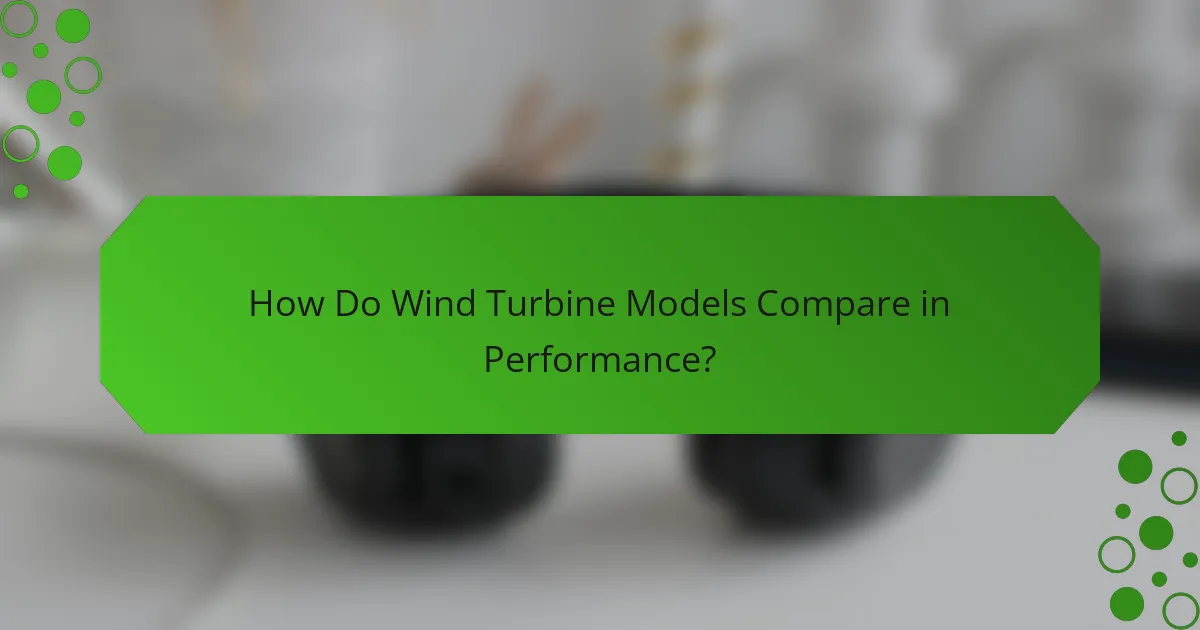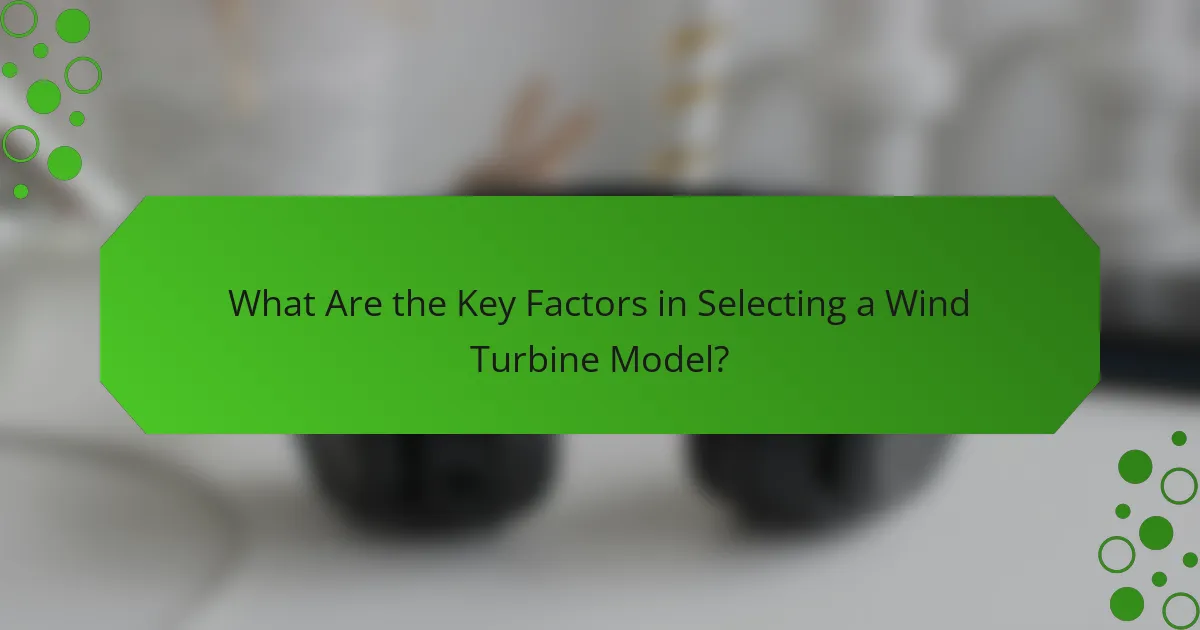Wind turbine models are engineered to optimize energy production while balancing costs and installation challenges. Factors such as rotor size, generator capacity, and design play crucial roles in their efficiency across different wind conditions. The investment in these turbines can vary widely, influenced by capacity, technology, and location, often ranging from hundreds of thousands to millions of dollars. Successful installation necessitates thorough planning, including site assessments and compliance with local regulations.

What Are the Most Efficient Wind Turbine Models?
The most efficient wind turbine models are designed to maximize energy output while minimizing costs and installation complexities. Key factors include rotor size, generator capacity, and overall design, which influence performance in various wind conditions.
GE Haliade-X 12 MW
The GE Haliade-X 12 MW is one of the most powerful offshore wind turbines available, featuring a rotor diameter of 220 meters. Its advanced design allows it to generate more energy than many smaller models, making it ideal for large-scale projects.
This turbine can produce up to 67 GWh annually, enough to power around 16,000 households. Its efficiency is enhanced by a high capacity factor, which is crucial for maximizing energy production in varying wind conditions.
Siemens Gamesa SG 14-222 DD
The Siemens Gamesa SG 14-222 DD turbine boasts a capacity of 14 MW and a rotor diameter of 222 meters, making it suitable for both onshore and offshore applications. Its direct drive technology eliminates the need for a gearbox, reducing maintenance costs and increasing reliability.
This model is designed to operate efficiently in low to moderate wind speeds, achieving a capacity factor of over 60%. Its modular design allows for flexible installation options, catering to diverse project requirements.
Vestas V162-5.6 MW
The Vestas V162-5.6 MW turbine is engineered for high efficiency, particularly in onshore wind farms. With a rotor diameter of 162 meters, it is capable of generating substantial energy, especially in areas with consistent wind patterns.
This model features advanced aerodynamics and a high-capacity generator, resulting in a capacity factor that can reach up to 57%. Its design allows for easy transportation and installation, making it a popular choice for developers.
Nordex Delta4000 Series
The Nordex Delta4000 Series includes various models with capacities ranging from 2.4 to 5.7 MW, tailored for different wind conditions. This series is known for its robust design and adaptability, making it suitable for both onshore and offshore installations.
These turbines are optimized for low wind sites, achieving high efficiency with a capacity factor of around 50%. Their modular design simplifies maintenance and enhances operational flexibility, appealing to a wide range of wind farm developers.
Goldwind GW154-2.5 MW
The Goldwind GW154-2.5 MW turbine is designed for efficiency in moderate wind conditions, featuring a rotor diameter of 154 meters. This model is particularly effective in maximizing energy output while maintaining a lower cost per megawatt-hour.
With a capacity factor of approximately 45%, it is well-suited for onshore wind projects. Its design emphasizes reliability and ease of maintenance, making it a practical choice for developers looking to optimize their investments in wind energy.

How Much Do Wind Turbine Models Cost?
The cost of wind turbine models varies significantly based on factors such as capacity, technology, and location. Generally, the price can range from hundreds of thousands to several million dollars per turbine, depending on these variables.
Average Cost per MW
The average cost per megawatt (MW) for wind turbines typically falls between $1.3 million and $2.2 million. This range can fluctuate based on the turbine’s size, efficiency, and the specific market conditions in different regions. For instance, larger turbines often have lower costs per MW due to economies of scale.
When planning a wind project, consider that the total cost includes not just the turbine itself but also associated infrastructure and installation expenses. This comprehensive approach ensures a more accurate budget estimation.
Cost Comparison by Model
Different wind turbine models exhibit varying costs based on their design and intended use. For example, onshore turbines generally cost less than offshore models, with onshore prices often starting around $1 million per MW, while offshore can exceed $3 million per MW.
Additionally, newer technologies, such as larger rotor diameters and advanced control systems, may have higher upfront costs but can lead to improved efficiency and lower operational costs over time. Evaluating the total lifecycle cost is crucial when comparing models.
Installation and Maintenance Costs
Installation costs for wind turbines can range from $100,000 to $300,000 per MW, influenced by site conditions and logistical challenges. Factors such as terrain, accessibility, and local regulations play a significant role in determining these costs.
Maintenance expenses typically account for about 1-2% of the initial investment annually. Regular inspections and repairs are essential for ensuring optimal performance and longevity of the turbines. It’s advisable to budget for these ongoing costs to maintain operational efficiency.

What Are the Installation Requirements for Wind Turbines?
Installing wind turbines requires careful planning and adherence to specific criteria to ensure efficiency and compliance with local regulations. Key factors include site assessment, permitting, and structural considerations.
Site Assessment Criteria
Site assessment is crucial for determining the viability of wind turbine installation. Factors such as wind speed, terrain, and proximity to infrastructure must be evaluated. Ideal locations typically have average wind speeds of at least 5-6 m/s.
Additionally, environmental impacts should be assessed, including effects on wildlife and local ecosystems. Conducting a thorough site assessment can prevent costly adjustments later in the installation process.
Permitting and Regulations
Obtaining the necessary permits is a critical step in the wind turbine installation process. Regulations vary by region, so it’s essential to consult local authorities to understand specific requirements. Common permits may include zoning, environmental assessments, and building permits.
Failing to secure the proper permits can lead to project delays or even fines. Engaging with local regulatory bodies early in the planning phase can streamline the permitting process.
Foundation and Structural Needs
The foundation is a vital component of wind turbine installation, as it supports the entire structure. Foundations must be designed to withstand the forces generated by wind and the weight of the turbine. Typical foundation types include concrete pads or deep foundations, depending on soil conditions.
It’s important to conduct soil tests to determine the appropriate foundation type and depth. Proper structural planning can enhance the longevity and stability of the turbine, reducing maintenance costs over time.

How Do Wind Turbine Models Compare in Performance?
Wind turbine models vary significantly in performance based on their design, capacity, and installation conditions. Key factors such as capacity factor, energy output, and durability play crucial roles in determining overall efficiency and cost-effectiveness.
Capacity Factor Analysis
The capacity factor of a wind turbine indicates the actual output compared to its maximum potential output over a specific period. Generally, modern turbines achieve capacity factors between 30% and 50%, depending on wind conditions and site characteristics. Higher capacity factors suggest better performance and more efficient energy generation.
When selecting a turbine, consider local wind patterns and regulations that may affect capacity. For instance, regions with consistent wind speeds may favor larger turbines with higher capacity factors, while areas with variable winds might benefit from smaller, more adaptable models.
Energy Output Estimates
Energy output estimates for wind turbines depend on their size, design, and local wind conditions. A typical onshore turbine can produce between 1.5 to 3 MW, generating approximately 4,000 to 6,000 MWh annually in optimal locations. Offshore turbines tend to have higher outputs, often exceeding 8 MW.
To accurately estimate energy output, utilize tools like wind resource assessments and energy modeling software. These resources can help project the expected generation based on historical wind data and turbine specifications, aiding in financial planning and investment decisions.
Durability and Lifespan
Durability and lifespan are critical factors in evaluating wind turbine models. Most turbines are designed to last 20 to 25 years, with regular maintenance playing a vital role in achieving this lifespan. Components such as blades, gearboxes, and generators should be regularly inspected and serviced to prevent costly downtimes.
Investing in high-quality materials and technology can enhance durability, reducing the frequency of repairs and replacements. Additionally, consider warranties and service agreements when selecting a turbine model, as these can provide added assurance regarding long-term performance and reliability.

What Are the Key Factors in Selecting a Wind Turbine Model?
Selecting a wind turbine model involves evaluating efficiency, cost, and installation requirements. Key factors include the turbine’s performance in specific wind conditions, the total investment needed, and the logistical aspects of setting up the turbine at the chosen site.
Location-Specific Considerations
When choosing a wind turbine, consider the geographical and environmental factors of the installation site. Wind speed, terrain, and proximity to infrastructure can significantly impact turbine performance and energy output. Areas with average wind speeds of 5 to 7 m/s are generally ideal for wind energy generation.
Local regulations and zoning laws also play a crucial role. Some regions may have restrictions on turbine height or placement, while others might offer incentives for renewable energy projects. Always check local guidelines before proceeding with installation.
Energy Needs Assessment
Assessing your energy needs is vital for selecting the right wind turbine model. Calculate your average energy consumption in kilowatt-hours (kWh) to determine the size and capacity of the turbine required. For residential use, a turbine that generates between 5 kW to 15 kW may suffice, depending on household energy demands.
Consider future energy needs as well. If you plan to expand your energy consumption, factor in potential increases when selecting a turbine. This proactive approach can prevent the need for costly upgrades or additional installations later on.
